When it comes to eye-catching foliage, the Hoya Polyneura is a rare beauty that truly takes center stage. Affectionately known as the “Fishtail Hoya,” this plant’s playful nickname gives a nod to its uniquely shaped leaves that resemble — you guessed it — fishtails.
As you stroll through the lush jungles of your own living room, you might find the Hoya Polyneura waving its whimsical fishtail leaves at you, inviting you to learn more about its delightful quirks and care requirements.
We’ll explore Hoya Polyneura care, its origins as a climbing plant native to the forests of Southeast Asia, and its new role as a charming addition to your indoor plant collection. There’s a lot more to this houseplant than meets the eye.
Table of Contents
Hoya Polyneura Plant Care Guide
History, Habitat, and Characteristics
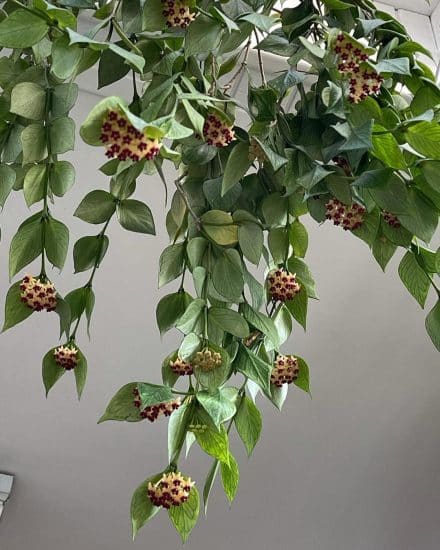
The Fishtail Hoya (Hoya polyneura) is a truly fin-tastic houseplant, native to the high-altitude regions of the eastern Himalayas in India. It’s sometimes called the Mermaid Hoya due to its distinctive foliage, which features ornate leaves that resemble a fishtail or mermaid tail.
The dark green leaves showcase bold, darker veins that create an eye-catching pattern. When basking in brighter light, the narrow and thin leaves take on a vibrant, pale green hue. But it’s not just the leaves that make the plant so enticing.
Blooming like other hoyas, the Fishtail Hoya produces ornamental, nectar-filled flowers that drip with a sugary syrup, making them irresistible to pollinators.
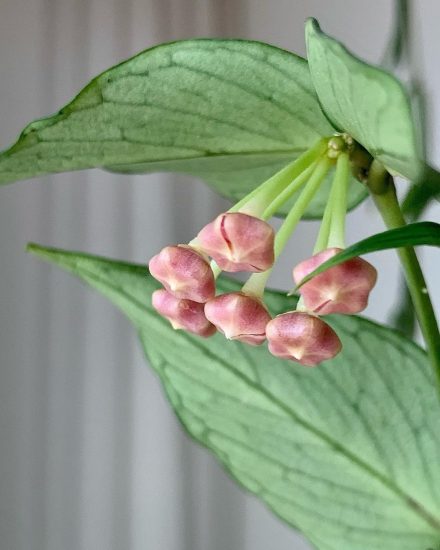
As a free-swimming epiphytic plant, it happily grows as a trailing plant without requiring any support and looks great in a hanging basket.
However, as Hoya Polyneura gracefully cascades its succulent-like leaves, it can cause the plant to become quite heavy. Don’t be surprised if it grows at a rapid pace — the Hoya Polyneura is one of the fastest-growing hoya species.
These hoya plants thrive in the cool, high-altitude environments of the Himalayas. Their natural habitat of cooler temperatures makes them the perfect houseplant companion, capable of compatibility with a variety of climates.
This aquatic-inspired plant has captivated the hearts of many collectors, earning it the nickname “Collector’s Hoya.”
Light
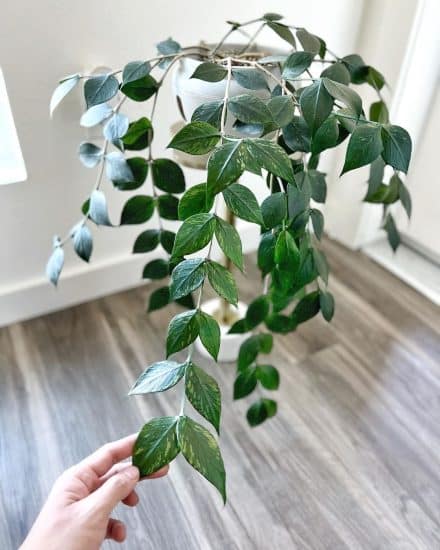
Hoya Polyneura craves bright yet subtle sunlight, so let’s help them bask in the best rays possible (without overdoing it, of course)!
To create the ideal lighting situation, place it near an east-facing window. This location supplies balanced medium light that keeps your plant content.
If you only have a west or south-facing window, don’t fret — simply move the plant a couple of feet back from the window to save it from direct sunlight exposure, which can scorch those pretty leaves. Alternatively, artificial light (we prefer full-spectrum LED) is an effective way to help your Hoya Polyneura.
Keep an eye on your plant for signs of poor light exposure, which could be dull leaves or slowed growth. Conversely, too much direct sunlight can lead to scorched or discolored foliage. The trick is finding the sweet spot that makes your hoya plants beam (pun intended!).
Our lighting tips:
- Aim for bright, indirect sunlight.
- An east-facing window is the ideal spot for medium light.
- For west- or south-facing windows, simply maintain some distance from the window to avoid direct sun.
Water
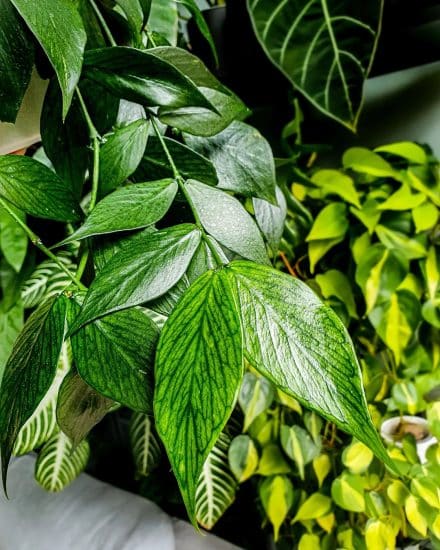
Caring for your Hoya Polyneura requires a balanced watering schedule that keeps the plant moist but not overly saturated.
You’ll want to let the soil dry down an inch or so (you can feel with a finger or a toothpick) before watering your Hoya Polyneura. Make sure you give it a full soak with the excess water draining out the bottom drainage holes of your pot.
Firm, solid leaves on your Hoya Polyneura indicate proper hydration, while wrinkly leaves signify dehydration. Adjust your watering frequency according to the season, providing more water during periods of growth and cutting back in winter or during dormancy.
Overwatering your Hoya Polyneura can lead to like root rot. Signs of too much water include yellowing leaves, mushy stems, and soil that just doesn’t dry. In this case, you’ll want to really let the soil dry out. Cut back on how frequently you water this hoya plant and take a look at our soil section to make sure you’re using an appropriate soil mix.
Temperature and Humidity
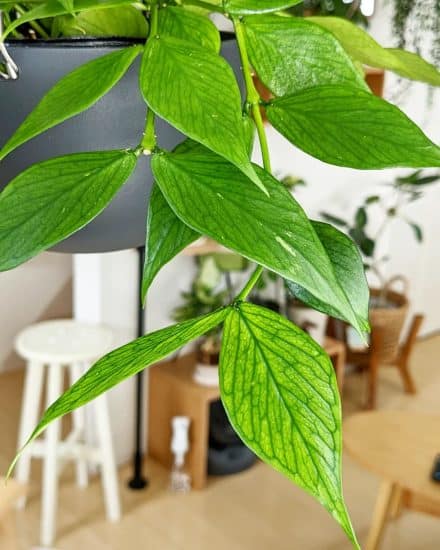
Temperature plays a significant role in the health of your Hoya Polyneura plant; it prefers a steady temperature of around 71°F (22°C). While it can handle a range of 77-83°F (25-28°C), this depends on factors like humidity and watering frequency.
Hoya Polyneura thrives during autumn and winter, when cooler nighttime temperatures are present. The stunning blooms on this plant arrive as the season shifts from summer to autumn.
To keep your plant comfortable, avoid placing it near direct heat sources or cold drafts. If the temperature is too high or too low, you’ll notice yellow leaves, wilting, or a lack of blooms.
Humidity plays another equally important role for your Hoya polyneura plant. Aim for humidity levels of 45%-50% during most of the year. During winter try to maintain 50-60% humidity to boost the plant’s chances of flowering.
Keep an eye out for signs that your plant needs a humidity adjustment. If you notice thin leaves that are wilting or have brown tips, that’s a good indication that the humidity is a bit too low. On the other hand, too much humidity can cause mold and mildew issues, potentially leading to rot.
To raise humidity:
- Use a tray of water and pebbles beneath the plant to increase humidity as the water evaporates.
- Place a humidifier in the room with your hoya plant.
- Cluster your Hoya Polyneura with other plants to share moisture through transpiration.
- If possible, move your plant to a well-lit bathroom where humidity levels are naturally higher.
Soil and Planting
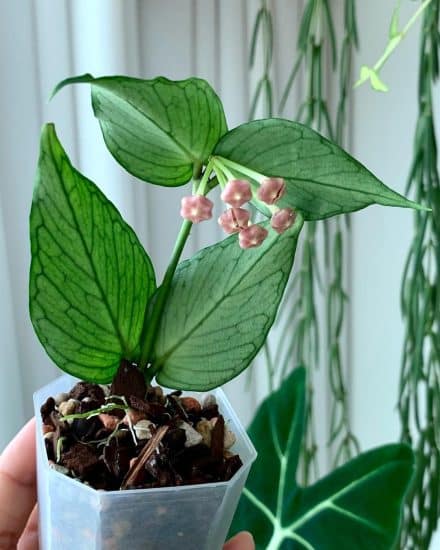
Hoya Polyneura thrives in a well-draining soil mixture that stays moist but not overly wet. Finding the right balance in the soil composition will help your Hoya Polyneura grow strong and healthy.
Tropical plant potting mix often contains well-balanced ingredients such as peat moss, vermiculite, and perlite.
An ideal potting soil mixture for Hoya polyneura includes the following ingredients:
- Perlite helps improve aeration, preventing the soil from becoming too dense and promoting healthy root growth.
- Charcoal removes impurities and toxins from the soil, contributing to the overall health of the plant.
- Orchid bark provides excellent drainage and aeration, allowing the roots to breathe and preventing root rot.
Fertilizer
Hoya Polyneura benefits from regular fertilization. You can use Dyna-Gro Foliage-Pro (9-3-6 formula) diluted to half strength in water or a weak orchid fertilizer every time you water. Reduce the dosage during winter, as fertilizer burn can lead to issues like yellowing leaves or damaged leaf tips as your plant tries to push excess salts out.
The fix isn’t too difficult: flush the soil with water to remove excess fertilizer and adjust your fertilizing routine accordingly.
Repotting
Repotting Hoya Polyneura is necessary every 2-3 years. The gorgeous plant will flourish when given fresh soil and a larger container for growth. Choose a pot that is just slightly larger than the current one, but avoid a size that has too much room. With too much room, the extra potting mix can reserve water and cause potential root rot.
Be sure your pot has at least a few drainage holes to avoid excess water pooling. Carefully remove the plant from its previous pot while being cautious to handle the roots gently. Transplant it into the new pot with new soil, tamping it down around the root ball to secure the plant in place.
Propagation
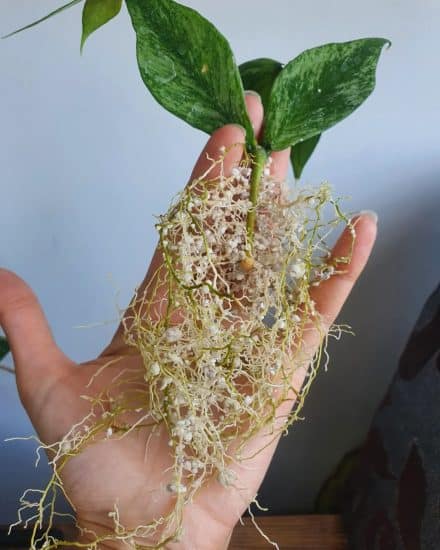
Stem cuttings are the way to go if you want to make more Hoya Polyneura for friends and fam.
Propagate Hoya Polyneura through single node stem cuttings:
- Select a healthy Hoya Polyneura plant. Picking a strong, well-growing plant with vibrant leaves and a sturdy stem will ensure the best outcome for your new stem cuttings.
- Clean your shears. Before making any cuts, sanitize your gardening shears or scissors with rubbing alcohol. This helps prevent the spread of infections and keeps both the mother plant and cuttings healthy.
- Cut just above a leaf pair. With your sterilized pruning shears, make your cut right above the leaf pair. This action will encourage new growth from the node.
- Divide the stem between leaf sets. After removing the stem, cut it into individual sections between each leaf set. Make sure each cutting has at least one node.
- Mist and apply rooting hormone. Give your cuttings a light misting with water, then dip the cut end into rooting hormone. This step promotes root growth and increases the likelihood of success.
- Prepare and dampen a pot with perlite. Fill a small container or pot with perlite and moisten it with water. Perlite offers excellent drainage and aeration, promoting healthy Hoya Polyneura root development.
- Insert cuttings in holes in the perlite. Make small holes in the damp perlite big enough for the end of each cutting. lace them in the prepared holes, gently pressing the perlite around the base to provide support for the new plant.
- Place in a humid environment. Keep the hoya plant inside a greenhouse cabinet or similar environment with 70-80% humidity. This high moisture level is ideal for root growth.
- Watch for progress. Keep an eye on your cuttings for new growth and root formation. This process might take a few weeks, so stay patient and maintain humidity levels.
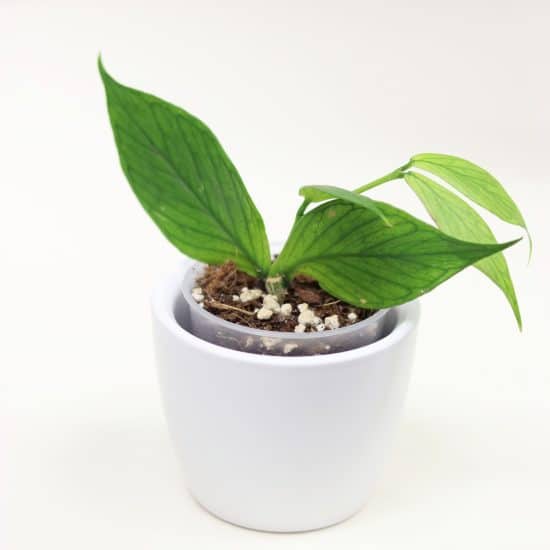
Common Issues
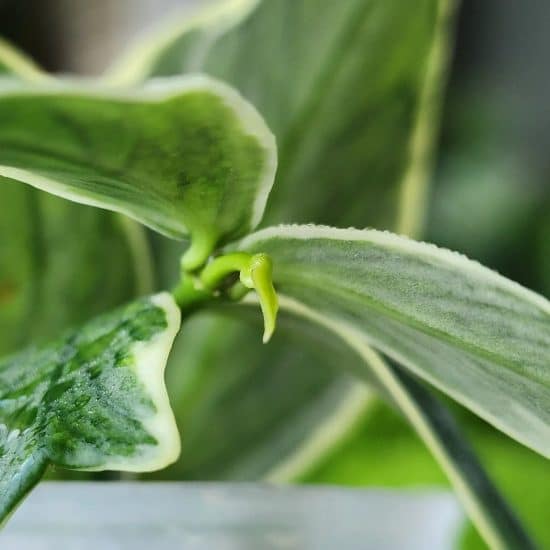
Hoya Polyneura can encounter a couple of common challenges as it matures. We’ll help you identify and solve these problems so your plant remains healthy and vibrant.
Falling Over
Hoya Polyneura’s beautiful succulent leaves can get so heavy that their weight causes it to fall over and become unbalanced. It’s essential to support your hoya as it grows by using a sturdy support system (such as a solid trellis or a robust wall hook) that can handle its increasing weight.
This will not only prevent falling, but also promote healthier growth. As an additional measure, consider pruning back excessively long vines to reduce the overall weight and maintain a well-balanced plant structure (this pruning can also encourage bushier growth).
Deformed Leaves
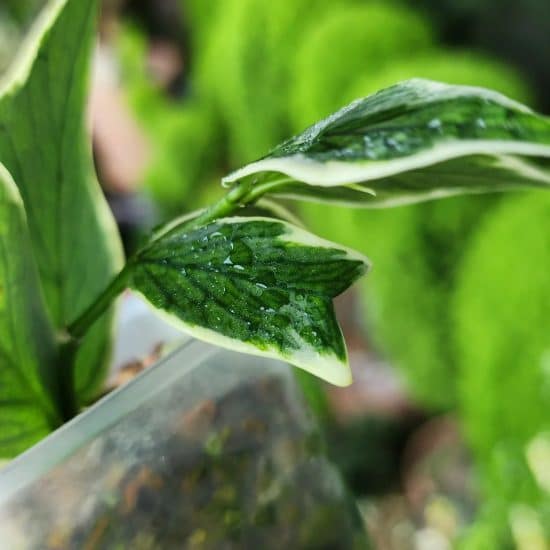
Deformed leaves on your Hoya Polyneura plant can often be as a result of low humidity levels during leaf development. To fix this problem, try using a humidifier or relocating it to a more humid environment (such as a bathroom or kitchen).
Some growers have found success growing their Hoya Polyneura in a semi-hydro system, which helps maintain consistent moisture and humidity levels, and can make watering more manageable. If you’re interested, you’ll want to plant in perlite and use a diluted hydro-fertilizer.
Pests and Diseases
Hoya Polyneura is usually an easy-going indoor plant, but it may encounter a few plant pests and diseases, causing it to be a more sensitive plant than you might expect. We’ll guide you through how to fix common problems like spotting.
Root Rot
This pesky problem can sneak up on your Hoya Polyneura plant if it’s been sitting in overly wet soil or lacking proper drainage. Keep an eye out for signs like black, mushy roots, drooping leaves, or a decrease in your plant’s overall health.
Here’s what you can do to help your hoya recover from root rot:
- Gently remove the Fishtail Hoya from its plant pot and trim away any damaged roots that look dark and slimy.
- Repot your plant in new, well-draining soil. Don’t forget to add some perlite or pumice to boost aeration and drainage.
- Only give your plant a drink when the top few inches of soil feel dry, and avoid letting it sit in standing water.
Mealybugs
Mealybugs can be tricky to control on Hoya Polyneura due to the plant’s unique growth pattern. These tiny critters resemble cotton balls and love to hide on leaves, stems, and sometimes even in the roots.
To bid farewell to mealybugs, follow these simple steps:
- Dip a cotton swab in rubbing alcohol and gently remove any visible mealybugs from the plant. If you don’t have alcohol, simply pick them off.
- Next, wash your plant with a mixture of water and a few drops of dish soap. Make sure to cover all surfaces, especially the undersides of leaves (that’s their favorite hiding spot).
- If those pesky bugs just won’t leave, it’s time to bring out the neem oil. This will resolve most plant pests. Follow the product’s instructions and your Hoya Polyneura should be bug-free in no time!
While we don’t recommend regularly misting leaves, if you notice mealybugs, this is actually a fine thing to do regularly. Mealybugs hate moisture! Just make sure to wipe the leaves down after to avoid fungal issues.
Conclusion
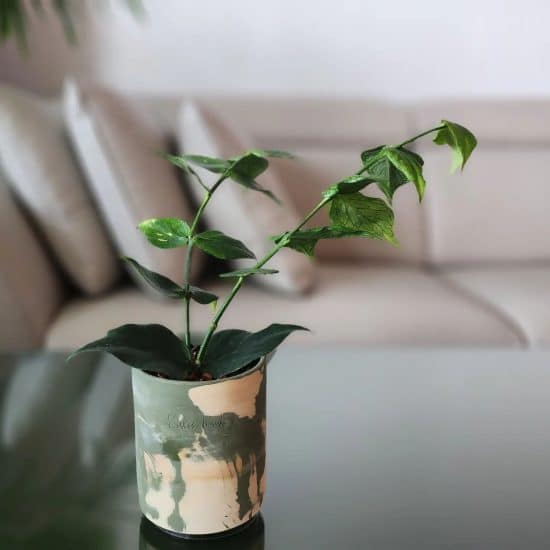
That’s it for our Hoya Polyneura care guide! You should now be well-equipped to keep this enchanting houseplant happy and healthy in its new home.
Hoya Polyneura care summary:
- Provide bright, indirect light for best growth and vibrant foliage. An east-facing window is ideal! Grow lights can be used when necessary.
- Maintain temperatures around 71°F and humidity levels between 45-60% (higher during winter) for optimal growth and flowering.
- Use well-draining soil mixes.
- Fertilize regularly with a diluted solution of Dyna-Gro Foliage-Pro or a weak orchid fertilizer.
- Propagate using a single node stem cutting method, and be patient — root growth may take a few weeks.
- Watch out for common issues, such as root rot and mealybugs, and address them promptly to keep your plant thriving.
Whether you;re just getting started or you’re already a seasoned plant collector, we hope this guide has provided you with valuable insight into caring for your Hoya Polyneura. If you have any questions or need further assistance, don’t hesitate to reach out to us.
And, as always, happy gardening!
FAQ
Is Hoya Polyneura easy to grow?
Hoya Polyneura plants are considered moderately easy plants to grow, especially for a gardener with some experience in caring for tropical plants. It requires consistently balanced temperature, humidity, and watering to thrive. Once you understand the plant’s preferences and can provide the appropriate conditions, your Hoya Polyneura will reward you with beautiful, lush growth and stunning flowers.
Where is Hoya Polyneura from?
Hoya Polyneura, or Fishtail Hoya, hails from the foothills of the Himalayas in Northern India, Nepal, and Bhutan. In this region, the plant is naturally found growing on trees in the cool mountainous environment. This origin plays a role in the Hoya Polyneura’s ideal conditions for growth, including its preference for cooler nighttime temperatures and higher humidity levels.
Does Hoya Polyneura flower?
Yes, Hoya Polyneura is famous for its stunning, fragrant flowers! When provided with the right conditions, the plant will produce beautiful clusters of star-shaped flowers that vary in color from pale yellow to white, and sometimes with a slight pink hue.
The flowers typically bloom during the seasonal transition from summer to autumn. Cooler nighttime temperatures are a key factor in flowering. To encourage blooming, ensure that you maintain a suitable temperature range and provide adequate humidity, especially during winter months.
Is Hoya Polyneura toxic?
Hoya Polyneura isn’t considered toxic, but it’s important to always exercise caution when handling plants, especially if you have children or pets. Although not poisonous, the sap of the Hoya Polyneura plant may cause skin irritation in some individuals.
As a rule of thumb, it’s wise to keep your Hoya polyneura plant — and all plants — out of the reach of curious children and pets to prevent accidental ingestion or uncomfortable reactions.


